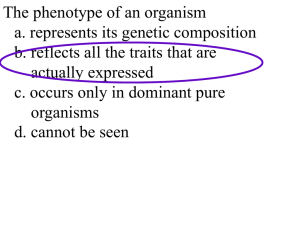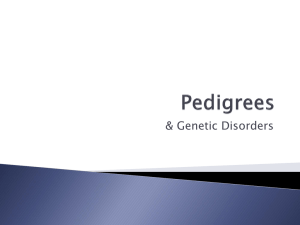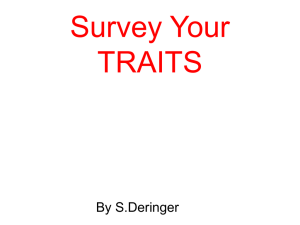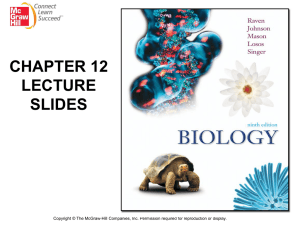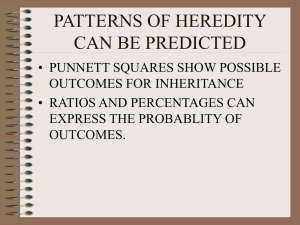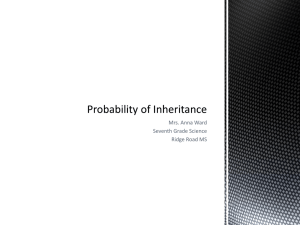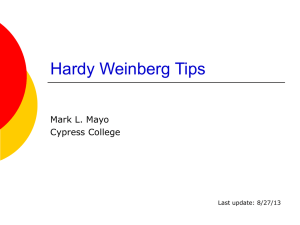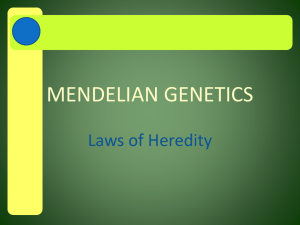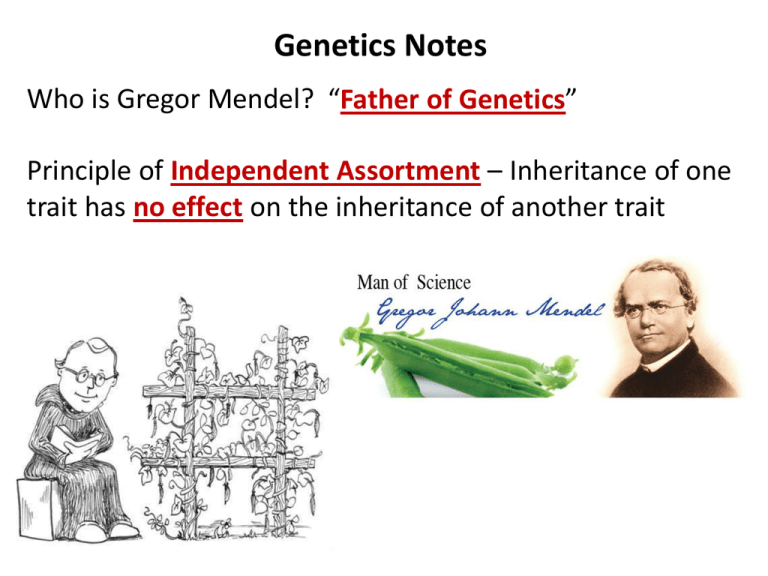
Genetics Notes
Who is Gregor Mendel? “Father of Genetics”
Principle of Independent Assortment – Inheritance of one
trait has no effect on the inheritance of another trait
Traits
• Genetics – study of how traits are passed from parent
to offspring
• Traits are determined by the genes on the
chromosomes. A gene is a segment of DNA that
determines a trait.
• Chromosomes come in homologous pairs, thus genes
come in pairs.
Homologous pairs – matching genes – one from female
parent and one from male parent
• Example: Humans have 46 chromosomes or 23 pairs.
One set from dad – 23 in sperm
One set from mom – 23 in egg
• One pair of Homologous Chromosomes:
Gene for eye color
(blue eyes)
Homologous pair
of chromosomes
Gene for eye color
(brown eyes)
Alleles – different genes (possibilities) for the same trait –
ex: blue eyes or brown eyes
Dominant and Recessive Genes
• Gene that prevents the other gene from “showing” –
dominant
• Gene that does NOT “show” even though it is present –
recessive
• Symbol – Dominant gene – upper case letter – T
Recessive gene – lower case letter – t
Dominant
color
Recessive
color
Example: Straight thumb is dominant to hitchhiker thumb
T = straight thumb t = hitchhikers thumb
(Always use the same letter for the same alleles—
No S = straight, h = hitchhiker’s)
Straight thumb = TT
Straight thumb = Tt
Hitchhikers thumb = tt
* Must have 2 recessive alleles
for a recessive trait to “show”
• Both genes of a pair are the same –
homozygous or purebred
TT – homozygous dominant
tt – homozygous recessive
• One dominant and one recessive gene –
heterozygous or hybrid
Tt – heterozygous
BB – Black
Bb – Black w/
white gene
bb – White
Genotype and Phenotype
• Combination of genes an organism has (actual gene
makeup) – genotype
Ex: TT, Tt, tt
• Physical appearance resulting from gene make-up –
phenotype
Ex: hitchhiker’s thumb or straight thumb
Punnett Square and Probability
• Used to predict the possible gene makeup of offspring –
Punnett Square
• Example: Black fur (B) is dominant to white fur (b) in mice
1. Cross a heterozygous male with a homozygous recessive female.
Black fur (B)
Heterozygous
male
White fur (b)
White fur (b)
Homozygous
recessive female
White fur (b)
Male = Bb X Female = bb
b
Male gametes - N
(One gene in
sperm)
B
b
b
Bb
Bb
bb
bb
Female gametes – N
(One gene in egg)
Possible offspring – 2N
Write the ratios in the following orders:
Genotypic ratio = 2 Bb : 2 bb
50% Bb : 50% bb
Genotypic ratio
homozygous : heterozygous : homozygous
dominant
recessive
Phenotypic ratio = 2 black : 2 white
50% black : 50% white Phenotypic ratio
dominant : recessive
Cross 2 hybrid mice and give the genotypic ratio and
phenotypic ratio.
B
b
B
BB
Bb
b
Bb
bb
Bb X Bb
Genotypic ratio = 1 BB : 2 Bb : 1 bb
25% BB : 50% Bb : 25% bb
Phenotypic ratio = 3 black : 1 white
75% black : 25% white
Example: A man and woman, both with brown eyes (B)
marry and have a blue eyed (b) child. What are the
genotypes of the man, woman and child?
Bb X Bb
Man = Bb
B
b
B
BB
Bb
b
Bb
bb
Woman = Bb
Crossing involving 2 traits – Dihybrid crosses
• Example: In rabbits black coat (B) is dominant over brown (b) and
straight hair (H) is dominant to curly (h). Cross 2 hybrid rabbits
and give the phenotypic ratio for the first generation of offspring.
Possible gametes:
BbHh X BbHh
BH
BH
Gametes
Bh
Bh
bH
bH
BH
bh
bh
BH
Bh
bH
bh
BBHH
BBHh
BbHH
BbHh
Phenotypes - 9:3:3:1
9 black and straight
3 black and curly
Bh
BBHh
BBhh
BbHh
Bbhh
bH
BbHH
BbHh
bbHH
bbHh
3 brown and straight
1 brown and curly
bh
BbHh
Bbhh
bbHh
bbhh
• Example: In rabbits black coat (B) is dominant over brown (b) and
straight hair (H) is dominant to curly (h). Cross a rabbit that is
homozygous dominant for both traits with a rabbit that is
homozygous dominant for black coat and heterozygous for straight
hair. Then give the phenotypic ratio for the first generation of
offspring.
BBHH X BBHh
Possible gametes: BH
BH
Bh
BH
Phenotypes:
100% black and straight
BH BBHH
Bh
Gametes
BBHh
Gametes
(Hint: Only design Punnett squares to suit the number of possible gametes.)
Sex Determination
• People – 46 chromosomes or 23 pairs
• 22 pairs are homologous (look alike) – called autosomes –
determine body traits
1 pair is the sex chromosomes – determines sex (male or female)
• Females – sex chromosomes are homologous (look alike) – label XX
Males – sex chromosomes are different – label XY
• What is the probability of a couple having a boy? Or a girl?
Chance of having female baby? 50%
male baby? 50%
X
X
X
XX
XX
Y
XY
XY
Who determines the sex of the child? father
Incomplete dominance and Codominance
• When one allele is NOT completely dominant over
another (they blend) – incomplete dominance
Example: In carnations the color red (R) is incompletely
dominant over white (W). The hybrid color is
pink. Give the genotypic and phenotypic ratio from a
cross between 2 pink flowers.
RW X RW
R
R
W
RR RW
W RW WW
Genotypic = 1 RR : 2 RW : 1 WW
Phenotypic = 1 red : 2 pink : 1 white
• When both alleles are expressed – Codominance
Example: In certain chickens black feathers are
codominant with white feathers.
Heterozygous chickens have black and white speckled
feathers.
Sex – linked Traits
• Genes for these traits are
located only on the X
chromosome (NOT on the Y
chromosome)
• X linked alleles always show
up in males whether
dominant or recessive
because males have only
one X chromosome
• Examples of recessive sex-linked disorders:
1. colorblindness – inability to distinguish between
certain colors
You should see 58
(upper left), 18
(upper right), E
(lower left) and 17
(lower right).
Color blindness is the inability to distinguish the differences between certain colors. The most
common type is red-green color blindness, where red and green are seen as the same color.
2. hemophilia – blood won’t clot
• Example: A female that has normal vision but is a carrier
for colorblindness marries a male with normal vision.
Give the expected phenotypes of their children.
N = normal vision
n = colorblindness
XN Xn X XN Y
XN
Xn
XN XNXN
XNXn
XNY
XnY
Y
Phenotype: 2 normal vision females
1 normal vision male
1 colorblind male
Pedigrees
• Graphic representation of how a trait is
passed from parents to offspring
• Tips for making a pedigree
1. Circles are for females
2. Squares are for males
3. Horizontal lines connecting a male and a
female represent a marriage
4. Vertical line and brackets connect parent
to offspring
5. A shaded circle or square indicates a
person has the trait
6. A circle or square NOT shaded represents
an individual who does NOT have the trait
7. Partial shade indicates a carrier –
someone who is heterozygous for the trait
• Example: Make a pedigree chart for the following
couple. Dana is color blind; her husband Jeff is not.
They have two boys and two girls.
HINT: Colorblindness is a recessive sex-linked trait.
XnXn
Has trait
XNY
Can pass trait to
offspring
Multiple Alleles
• 3 or more alleles of the same gene that code for a single trait
• In humans, blood type is determined by 3 alleles – A, B, and O
BUT each human can only inherit 2 alleles
1. Dominant – A and B (codominance)
Recessive – O
2. Blood type – A = AA or AO
B = BB or BO
AB = AB
O = OO
Example: What would be the possible blood types of
children born to a female with type AB blood and
a male with type O blood?
AB X OO
A
O AO
B
BO
O AO
BO
Children would be type A or B only
Mutations
• Mutation – sudden genetic change (change in base pair
sequence of DNA)
• Can be :
Harmful mutations – organism less able to survive:
genetic disorders, cancer, death
Beneficial mutations – allows organism to better
survive: provides genetic variation
Neutral mutations – neither
harmful nor helpful to organism
• Mutations can occur in 2 ways:
chromosomal mutation or
gene/point mutation
Chromosomal mutation:
• less common than a gene mutation
• more drastic – affects entire chromosome, so affects
many genes rather than just one
• caused by failure of the homologous chromosomes to
separate normally during meiosis
• chromosome pairs no longer look the same – too few or
too many genes, different shape
• Examples:
Down’s syndrome – (Trisomy 21) 47 chromosomes,
extra chromosome at pair #21
Turner’s syndrome – only 45 chromosomes, missing a
sex chromosome (X)
Girls affected – short, slow growth, heart problems
Klinefelter’s syndrome – 47 chromosomes, extra X
chromosomes (XXY)
Boys affected – low testosterone levels, underdeveloped
muscles, sparse facial hair
• Having an extra set of chromosomes is fatal in animals,
but in plants it makes them larger and hardier.
Hardier
Gene or Point Mutation
• most common and least drastic
• only one gene is altered
• Examples:
Recessive gene mutations:
Sickle cell anemia – red
blood cells are sickle
shaped instead of round
and cannot carry enough
oxygen to the body tissues
– heterozygous condition
protects people from
malaria
Cystic fibrosis – mucous builds up
in the lungs
Tay-Sachs Disease – deterioration
of the nervous system – early
death
Mutated genes produce enzymes that are less
effective than normal at breaking down fatty
cell products known as gangliosides. As a
result, gangliosides build up in the lysosomes
and overload cells. Their buildup ultimately
causes damage to nerve cells.
Phenylketonuria (PKU) – an amino
acid common in milk cannot be
broken down and as it builds up it
causes mental retardation –
newborns are tested for this
Dominant gene mutations:
Huntington’s disease – gradual
deterioration of brain tissue,
shows up in middle age and is fatal
Dwarfism – variety of skeletal
abnormalities
Detecting Genetic Disorders
• picture of an individual’s chromosomes – karyotype
• amniotic fluid surrounding the embryo is removed for
analysis – amniocentesis
Female with Down’s syndrome


